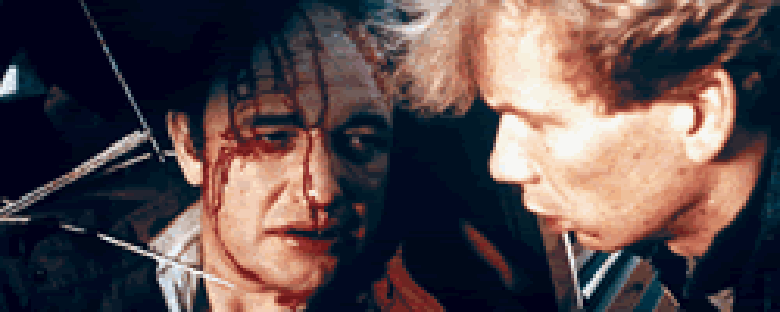Reviews
Krótki film o zabijaniu
Krzysztof Kieslowski
Poland, 1988
Credits
Review by Rumsey Taylor
Posted on 11 July 2004
Source Kino Video DVD
Related articles
Features: Kieslowski’s Trois Couleurs
Features: The Best DVDs of 2003; The Top-Ten
Reviews: A Short Film About Love
There are two deaths in Krzysztof Kieslowski’s A Short Film About Killing: a taxi driver is strangled by an adolescent male, who is later sentenced to death in the same manner. These occur over a year apart, but because of the manner in which Kieslowski arranges his film — each half is devoted to each killing — it is implied, despite the context and motivation for each death, that there is little difference between them.
The film is set in a desolate, saturated Polish setting that feels tactile and organic. This is indebted almost exclusively to Slawomir Idziak’s experimental cinematography. Much of the film is shot in partial green filters, taped in makeshift to the camera lens. At times, a corner of the frame is completely obscured, and many more shots are haloed. The photography is invariable to this environment, and has inherited its grime and wear.
The film has an overall tone of malevolence. Its opening finds a sewer littered with dead rats. We see children running away from a cat they have hung on a playground. We follow Jacek, a bored, hostile teen, ridden with acne and a disoriented frock of hair. He is given little establishment prior to a story he later shares in jail, aside from a photograph he carries of a presumed relative. In montage a cab driver, the future victim, is introduced and also given malevolent impulses, as he honks to frighten a dog away from his owner.
Jacek hails the cab and inefficiently kills the driver. (The scene that details this is lengthy and gruesome.) Significantly, this murder is difficult. Deaths in film are generally of expendable, anonymous characters. Here, it is uncommonly frightening, not because it involves a character with whom we sympathize, but because we see the effort it takes, and for no possible justification. Jacek observes the face of his expired victim, whose eyes are frozen in permanence towards him.
He returns with the cab to his girlfriend, and makes a genial offer to take a trip. This is followed immediately by an enormous jump cut that arrives at Jacek’s sentencing, a year later. This omission of material relays the strength of efficiency in Kieslowski’s filmmaking. This, as with each film in The Decalogue, is storytelling interested exclusively in individual characters, their essence and individual emotions. There are no superfluous elements.
A Short Film About Killing is classified by obscenity in its subject and depiction. This is contrasted by a third character, a lawyer, who is naïvely optimistic and ethical. His shared happiness (passing a crucial Law exam, news of his pregnant wife) precedes each killing. In the second half of the film, after representing Jacek in court, he meets his client in jail on the day of his execution. Jacek shares his past, his frustration and disappointment — for the first point in the film, he is sympathetic. Promptly, the meeting is interrupted, and Jacek is taken to be executed.
Strong dialectics characterize each entry in Kieslowski’s ten-part Decalogue. Each film is divided similarly between ethical oppositions or parties in conflict. This is filmmaking that elicits subjective response and engagement — these are films that intend to confront their viewer. This dialectic is its strongest in A Short Film About Killing (Decalogue V in its original incarnation), and this is one of a preeminent filmmaker’s most vital films.
We don’t do comments anymore, but you may contact us here or find us on Twitter or Facebook.



